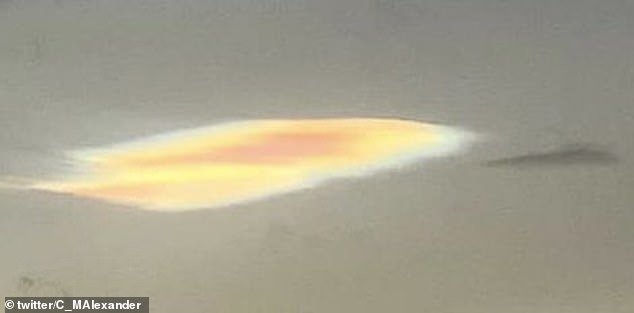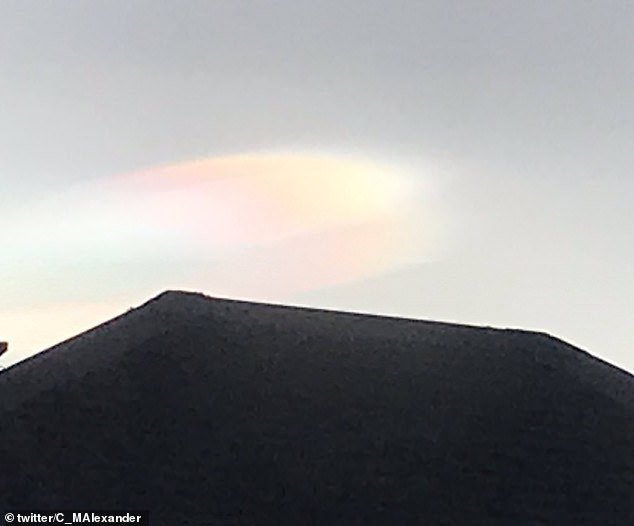Rare ‘mother of pearl’ clouds appear in the skies over Scotland
>
They look like a stunning Impressionist masterpiece or a puddle of petrol in the sky.
And while ‘mother of pearl’ clouds are usually a rare sight in the UK, they’ve been spotted in Scottish skies this week.
Photographers across Aberdeenshire, the Highlands and Moray have snapped shots of the curious formations, formed of tiny ice particles that scatter light.
Also known as nacreous clouds, the large thin discs are typically seen over Norway and other polar regions when the sun is just below the horizon.
Nacreous clouds need temperatures below -108°F (-78°C) to form, a temperature found much higher up in the stratosphere (the second layer of the atmosphere of Earth)
Nacreous clouds are most commonly seen in Antarctica, but have also been observed in the Arctic, Scotland, Scandinavia, Alaska, Canada and Russia.
One BBC Weather Watcher said: ‘Absolutely fantastic Nacreous cloud caught at tonight’s sunset with some gulls flying over. What a fantastic sight to behold.’
Another simply said there was a ‘strange thing in the sky’.
Due to their rare and unusual appearance, nacreous clouds have been mistaken by some as aurora borealis, while others have compared them to UFOs.
Officially known as polar stratospheric clouds, these formations are unique because they form higher in the sky than normal clouds and in colder conditions.
‘Nacreous clouds will only form when the temperature in the stratosphere is below a chilly -78°C [-108°F], which turns any moisture in the air into super-cooled liquid or ice crystals,’ said Nathan Case, a space physicist from Lancaster University’s Department of Physics.
‘Such temperatures generally only occur in the winter at high latitudes.’
While most clouds form in the troposphere, the lowest layer of Earth’s atmosphere, nacreous clouds form in the stratosphere, the next layer up.
Usually, temperatures are not cold enough over the UK for nacreous clouds to form.
They become visible here when the cold air that circulates around polar regions in the stratosphere (the polar vortex) is displaced and hovers temporarily over the UK.

Compared with low altitude clouds, nacreous clouds stand in almost the same place – an indicator of their great height.
The ice particles that form nacreous clouds are much smaller than those that form more common clouds.
These smaller particles scatter light in a different way, which is what creates the distinctive appearance.
The clouds are illuminated from below, after sunset and before sunrise, and often glow in vivid ‘pearl-like’ colours.
Such colours are reminiscent of the colours that reflect from a thin layer of oil on top of water – an effect known as iridescence.
It’s been thought that Edvard Munch’s famous painting ‘The Scream’ depicts nacreous clouds in the background.
Compared with low altitude clouds, nacreous clouds stand majestically in almost the same place – an indicator of their great height.
Because they are thin, these clouds are typically not visible during daytime, but before sunrise or after sunset.
In 2016, following sightings of nacreous clouds in the UK, reports were received by AuroraWatch UK wrongly identifying the clouds as aurora borealis, also known as the Northern Lights.
Aurora borealis is caused by collisions of electrically charged particles from the sun colliding with particles in Earth’s atmosphere, but the two are not linked.
However, as well as being beautiful, nacreous clouds are destructive and are a large contributing factor in the formation of holes in the ozone layer.
The ozone layer, which is also in the stratosphere, is a thin region that absorbs almost all of the sun’s harmful ultraviolet light.

Nacreous clouds will form in the stratosphere over polar regions when the Sun is just below the horizon
Ice crystals in the clouds encourage a chemical reaction between the ozone layer, which is made up of a specific type of molecular oxygen (O3) and gases such as chlorine and bromine
Nacreous clouds provide an ideal surface for chemical reactions involving CFC-derived compounds, created by humans that have ended up in the stratosphere.
As the CFC compounds react with the clouds when they are bathed in sunlight, chlorine gas is released, which damages naturally occurring ozone.
A single chlorine atom is capable of destroying thousands of ozone molecules, meaning chlorine is able to decimate parts of the ozone layer.
